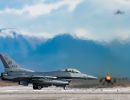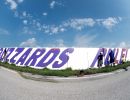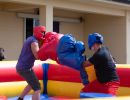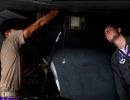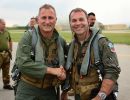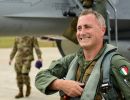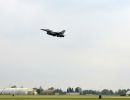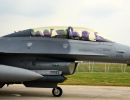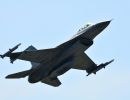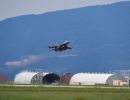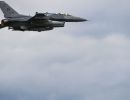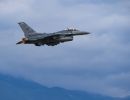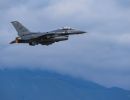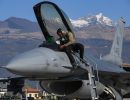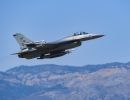"My" 405th Fighter-Bomber Group, judging from the fact that all three squadrons remained in service until the 1990s, was one of the deadliest, if in fact the least storied by historians, fighting units in U.S. history. (The Squadron I commanded for several months after D-Day, the 510th, remains on active duty at Aviano, Italy with its F- 16s and was heavily involved in the Kosovo War. The 509th and 511th were, to the best of my recollection , based at Upper-Heyford flying A-10s in the 20th Fighter Wing. It has 6 squadrons versus the normal three. They were probably deactivated around ten years ago.)
The first question to clear up now at the outset of my comments would be the air order of battle - or more simply, those fighting units which day-in and day-out., week-after-week and month-after-month provided vital low-level close air support to our infantry, artillery and armored units. The bomber elements of the 9th Air Force - the so-called Invasion Air Force - consisted of Martin B-26 and Douglas A-20 aircraft which flew in boxes at 10, to 12,000 feet conducting level bombing. That Invasion Force's fighter aviation consisted of the Lockheed P-38, North American P-51, and Republic P-47 in the following numerical relationship: One Group of P-38s filling the role of reconnaissance, one Group of Mustangs (P-51), and fifteen Groups of P-47 fighter-bombers. 94 percent of all direct support, ground attack missions thus were flown in designer Alexander Kartveli's versitile, ultimate dream fighter, the Thunderbolt, by probably the most. intrepid pilots churned out of America's cadet schools. And our low-level attack and ground-support function offered many more opportunities and ways to lose life and limb to enemy action than did any other form of aerial activity.
Most WW II historians have tended to lump together all fighter and attack aircraft, without. regard to whether they were in the 8th Air Force in predominantly bomber escort rolls from England or Italy, or in the 9th Air Force that would be flexibly based on the Continent as close as possible and practicable to the fluid front lines for the main purpose of supporting our ground forces, as fighter-bombers assisting the infantry and armor to forge ahead against the Germans. Our `bombing' was 90 percent divebombing, From D-Day on, the 8th Fighter command was 90 percent Mustang equipped. These aircraft did their superb job of escort and , when on a given mission they were relieved by another P-51 outfit, they customarily descended to the deck to strafe German trains and airfields while more or less independently enroute to their home stations across the English Channel. But, in terms of helping fill the prisoner-of war ranks or lonely foreign graves after introduction to the multiple barrels of German 20mm flak guns (today termed `Triple A') they also paid the same high price as many of the 9th Air Force P-47 pilots would and did. Thus, the 8th Air Force fighters seldom performed close ground support of our armies as the 9th was assigned to do; the two forces had some different, specialized fish to fry.
There was no "A" type - i.e., `attack' aircraft - in the theater that could actually perform its original, theoretical drawing-board planned task; that is, an active, effective career of attacking ground targets from or at low levels. The A-20, principally augmenting the Martin B-26, didn't do it; it did not go down on the deck and daunt the barrels of flak guns assigned to German Panzar divisions. In my judgment, potential losses of this sassy little Douglas twin, and/or any aircraft using the in-line Merlin or Allison liquid-cooled engine ordered to do so, would have been unacceptably high, Aircraft such as the P-39 (Bell), P-40 (Curtis), A-24 (Douglas), A-35 (Vultee) and A-36 (an altered look-alike P-51), simply weren't to be found in American hands over Europe, although, of the 200+ Vultee A-31/35s built, there were some bought by the British and some flown in American bomb groups doing domestic chores, mostly `taxiing' the brass around or towing gunnery sleeve targets. Each of these types mentioned had some characteristic, or its plural, that made it dangerously unsuited for dive-bombing and low-level strafing of an alerted enemy in a way that was effective. Moreover, I'm aware of no naval or marine ground attack air units being used over Germany or occupied France. That left the horsepower, the rugged durability, the speed, and the pure mass of the big Republic P-47 to finally prove that it was the best of designs in the variety of combat situations we encountered in meeting the demands of low-level support and interdiction assignments.
Aside from all its virtues as a fighter-bomber, the old (original) `razorback' P-47s did have a serious flaw, it must be said, which had something to do with pilot training and everything to do with combat flying. Its rearward visibility from the enclosed cockpit was badly limited, making it impossible for a pilot to scan his 'six o'clock' position for following - which meant `pursuing' - friendly or unfriendly traffic. You cannot have this condition in a single-engine fighter, but all of the older Jugs' did. The fact that this airplane could out-dive any thing in the enemy aviation arsenal (for most of World War II) was an advantage only until the diving was over with
But the Air Force ultimately got this matter back onto the Republic company's drawing boards and the fuselage was re-designed to accept the new molded plexiglass cockpit bubble canopy. It seemed the final remedy, and it in fact did solve the pilots' visibility problems but in doing so created a new one: deteriorated aerodynamic airflow over the empennage. Test flight revealed that eliminating the dorsal keellike razorback cross-section configuration, and making it essentially round , induced dorsal air burbles over the horizontal and vertical stabilizers rendering them unstable, particularly at landing approach speeds - and this was not good, actually, in any flight regime. Thus, the very latest P-47-D's came with the addition of a dorsal fuselage-to-tail fairing, and we lived happily ever after. The fairing also could be added "in the field" by our heroic, hardworking ground crews. The modification was a small but vital fix.
About the men who flew combat in the P-47. Group commanders were about 27 years old - from the cadet classes of 1939 or 1940. Squadron commanders averaged 25 years of age, from the graduating classes of `41 and/or '42. Squadron `line pilots' ranged from 19 to 24 years, averaging 22, and were from classes of `43 and `44. Half were unmarried.
When we went into combat the average American fighter pilot had about 250 flying hours, accumulated during the three standard training phases of cadet pilot schools. With a very, very few exceptions, each also had logged around fifty hours' transition time in P-47s. My own log books also showed 800 hours as a P-39 and P-40 instructor. Every hour helped.
Toward the end of 1943, both 8th and 9th Air Force Thunderbolt elements began returning "on the deck" from escort missions over occupied Europe seeking enemy surface targets of opportunity for their unused ammunition while making their way back to and across the English Channel. Our first 405th Fighter Group base in this phase of the war was at Christchurch, Dorsettshire, very near the Channel coast in extreme southern England. Our three squadrons operated from there from early March to early July of 1944, when our ground forces were gaining a secure foothold on the Continent after D-Day and Air Force engineers could carve us an airfield from a crabapple orchard on the Cherbourg Peninsula at a town named `Picauville'. In the course of these flexible activities it was conclusively learned that our `Jug' was quite well suited for this new role, leading to successfully adapting the Thunderbolt permanently as a fighter-bomber.
Once the high-flying, far-ranging P-51 Mustangs began to take over the needed long-range bomber escort tasks, the 9th Air Force Thunderbolts were largely diverted into the highly hazardous ground attack role, where they would truly earn and attain their main reputation as fighter-bombers. It was a role in which the Mustang, though a wonderful air-to-air combat fighter, was much, much more dangerous for its pilot when exposed to low-level flak defense means and measures than was the rugged P47, for the most part because of the Mustang's vulnerable liquid cooled, in-line engine. In May of 1944, still flying out of Christchurch, my 510th Squadron and the forty-odd squadrons of other P-47 groups variously stationed in southern England were to provide air cover for the impending June 6th invasion, after which we were to give much vitally needed ground support to speed the advancing Allies' surface action. Our `Jugs,' with their eight 50-caliber harmonized wing guns, and our bombs and rockets, were extremely effective in eliminating enemy forces in the face of the Allied advance. Yet the 47s continued to rack up an appreciable number of air-to-air kills against the Luftwaffe, while they still "beat up" the Wehrmacht on the ground in their destructive bombing and strafing career.**
(** Joseph Burgher, R, Jenkins, Jenkins' Jerry Junkers.)
After the Germans finally became convinced that the allied Normandy invasion was in fact an invasion and not merely a feint, they started moving massive amounts of men and material toward the peninsula's beaches. Our task became one of interdiction in earnest, with the highest priority given to attacking trains and Panzer divisions moving west and north Our (510th) Squadron, as with others in our Group would be assigned a rectangular area and we w free to pounce on any and all military targets in it until our bombs and ammunition were exhausted. This we did enthusiastically, some of the technique being learned at first hand, "on the job." And at our low operating altitudes we could always observe the satisfying results of our efforts.
The lessons we had been taught back in the States about dive-bombing and low-level attack, left quite a bit to be learned about. flying, and about War. It was necessary to evolve our own creative tactics and were given the widest possible latitude - out of sight, out of mind, loose rein, as it were - to do so. Through trial and sometimes serious error, unfortunately, we were able to devise the most efficient techniques for interdiction and armed reconnaissance missions. Standardly, we would cross the front lines at 10,000 feet, then descend to 5,000 on reaching an assigned target area. Then we flew parallel to the road or railroad tracks, establishing a 30-degree from vertical line of sight.
Upon spotting tanks or a train, bombs were armed and we executed a split-S maneuver as the target passed beneath the wing's leading edge. Thus a near vertical dive - like the stoop of a hawk - was established. We would center our gun reticules on the target and release our bombs at about 2,500 feet, with immediate recovery from the dive. I have seen a pair of bombs straddle a tank and destroy it - the bomb shackles are about 20-feet apart on a P-47. After bomb release our strafing attacks were initiated and continued until all our ammunition was gone.
After D-Day, but before our Group moved our base to Normandy from England, we were soon assigned to attack a Panzer division, south of Caen. Over the French coast we encountered an under-cast with tops at 4,000 feet and a base at 2,000. Navigating by dead reckoning, we entered the cloud cover in very close formations and broke out over a field filled with German tanks undergoing refueling and maintenance. We dropped our 500-pound bombs by glide bombing and then strafed until all ammunition was exhausted. The field was by then a mass of burning vehicles.
During the ten-minute attack, as with virtually all other missions, the sky was filled with anti-aircraft fire and, as we re-formed for the return to Christchurch, battle damage was called in. Every one of our P-47s had been hit, including General Ferguson's - he flew with us occasionally. My aircraft, 'razorback' # 2Z F - Tallahassee Lassie, was bathed in oil - a cylinder had been shot away - and I had to fly home to England with the canopy open in order to see. This mission, as on many others to follow, demonstrated the superiority of an air-cooled engine over a `wet (liquid cooled) one, convincingly vindicating its designer's steadfast opinions about the differences, and just how tough the P-47 was.
It was many times shown that the 20-mm multi barreled cannon was commonly our most formidable adversary, although the 40-mm's caused much heavier damage, shell for shell. And the German gunners were brave, for if we saw the tell-tale smoke from their barrels we would turn our eight 50-caliber guns on them before resuming our attack on the target which they were - or had been defending. Eight fifties concentrated in a converged pattern were very, very destructive.
So it was the P-47s - some 1,200 of them - with their single, 18 cylinder, 2,000-horsepower radial, aircooled engines, that for almost a year, June 1944 to May 1945, were dispatched from our often short, crude airstrips in western and northern France, and later from captured Luftwaffe fields in Germany, to perform armed reconnaissance and destroy hostile targets along the front line by dive-bombing and/or strafing (sic). Often these were tanks hunkered down in the Norman hedgerows. And often too, the tanks were briefly `marked' by colored smoke from our artillery only minutes prior to our dive-bombing them. What the ground artillery lacked, our Jugs made up for.
Described by military purists as a communication zone, the area immediately behind a front is where an army brings up its reinforcements and supplies, prepares fall-back positions, and moves its troops rearward or laterally. It is a location of much preparedness activity offering many `juicy' interdiction targets: In any flyable weather, in Squadron and Group strengths, our marauding P-47 fighter-bombers hounded and then paralyzed the German army during any daylight hours in this zone. Our own troops on the front wouldn't have a clue as to what we were up to as they saw us cross the line on missions identified as interdiction or isolation of the battlefield. But, they would learn what we had been up to as the front moved forward and they traveled along roads clogged with burned-out German tanks, trucks and self-propelled mobile artillery. They also saw `dead' locomotives, burned box cars, cratered rail marshaling yards, cut lines, and downed bridges. The zone could be as much as 200 miles deep and littered with wreckage of the Nazis' war machine, much of it strewn along once-viable, active, rural roads.
In the chaotic mess in which the Germans found themselves after Patton's 3rd Army, late in July, had broken through their front and gained a real foothold at St. Lo - thanks to a devastating earlier bombardment by 8th Air Force heavies, the 9th's B-26s, and Thunderbolts of the 9th AF, breaking the stalemate and blasting a much needed hole for the troops - they were being forced right off the Peninsula. They had to forsake their "communication zone" activities, or any semblance of it, and try to escape any way possible, and there was only one way to do it: as fast as possible leave via the thirty-odd miles of road from St. Lo southward toward Avranches, beyond which they hoped for a chance to re-group. It was this situation that made it possible for my 510th Squadron (of the 405th Fighter Group) to achieve an unforgettable coup over their fleeing column. I think I can describe it pretty much in the way it happened.
On one of the many critical armed reconnaissance our Group was assigned, on the morning of July 30th, 1944 (we had been at Picauville just a month then) we were to patrol the Cherbourg (Contentin) Peninsula's St. Lo -Avranches route, as the Germans had initiated their escape to the south by the most direct ground route. We were looking down for them, each Squadron patrolling in its assigned rectangular piece of geography, above where the road was believed to be, five thousand feet above a low, dense morning fog undercast layer that concealed everything below it, including the desperate fleeing German force on the road. It was typical weather for a July morning. Quite suddenly my 510th reached the end of the low cloud formation and I spotted a column of German vehicles stretching for miles, bumper to bumper in their grand retreat. It was naked, and we were only minutes from our forward (also our first in France) base at Picauville/ St. MereEglise, near Utah Beach. I called Operations, and Operations radioed XIX TAC (19th Tactical Air Command) with the news, and the attack was on. We continued until passing the head of the column, by about a quarter-mile, and prepared to dive.
One by one we half-rolled into our usual split-S dives, thus reversing our direction so we could strike the leading German vehicles, to block the road for the others by disabling them and at the same time catering the road to uselessness with our 500-pound bombs. Then a systematic strafing ensued against the halted German `rolling stock' which in fact had now stopped 'rolling.' It was a proverbial turkeyshoot. Each of our three squadrons had about fifteen minutes each to 'unload" on the column. All three made a couple of round trips to our base, reloading each time until, when it was over, we had destroyed 440 highly vulnerable German vehicles in less than a couple of hours' bombing and strafing. For that, the Group's pilots earned a `slew' of their Air Medals. The operation was highly economical for Uncle Sam. It was so successful the sick patient died.
In those long days and fine weather of the summer of 1944 it was conclusively demonstrated that the fighter-bombers prevented the Germans from bringing up their sorely needed reinforcements in an effort to hold back the Allied advance on the Cherbourg (Contentin) peninsula. Our enemy was unable even to retreat to re-group again.
And, at our new forward base camp, Picauville, on the Cotentin peninsula near St. Mere-Eglise, only three or four miles upland of the famed Utah Beach we were so near the front lines we could hear the rumble of artillery duels. It was quite unlike being stationed earlier in south England at our former Christchurch base, flying armed recon and bomber-escort missions to the Continent that were measured in hours - not minutes - or in the number of times we had to reach for the relief tube. Indeed we were now so close to the front that after taking off we had to circle the field for a few minutes to gain the 10,000 feet altitude needed to cross the lines in relative safety. We would in fact be bombing and strafing within ten minutes - even less if the FAC (Forward Air Controller) called for help for front-line units.
Our Picauville runway was barely 4,000-feet long and was covered with a heavy tarpaper that was called Hessian Matting and featured hot-tarred joints. Technically, in the jargon of the Army, it was 'Prefabricated Bitunfnous Surfacing' and there were a few similar others in Normandy which had to serve other P-47 Groups until the allies had recaptured better German/French airfields for our use. After the Air Force engineers had done their tree-clearing, leveling, packing and rolling, they had laid this matting at Picauville in only one day. Then they quickly built the Group 36 hardstands and taxi strips, all packed and covered with wire mesh. The strip crudely served our purposes but got kind of spongy when the soil underneath would get soggy, a condition which combined with the runway's shortness, made take-offs a bit `dicey," according to ex-510th pilot Charles Mohrle, who has aptly described this unusual piece of aviation engineering. The next field we moved to at St. Dizier, France, was decidedly more sophisticated, having been a French installation before the German takeover. Mohrle adds,"I don't recall their locations, but there were other tarpaper strips in use and I landed on one near Omaha Beach and another near Cherbourg."
Tanks camouflaged in hedgerows were hard to see and hard to dislodge. Our artillery would sometimes mark them with smoke shells and the squadron formation could then put some of our 500-pound bombs on them. We would also destroy buildings that had been identified by the French Underground as being used as a German headquarters. Troublesome enemy artillery units were strafed upon request, using a common communication method cooperatively employed between our ground and air units. It had developed into the highest state of the art of the era, one that kept fighter-bomber units such as our 405th FBG very active.
"Attack a flak battery? You got to be kidding." These were my thoughts one day upon watching an operations order clicking off the teletype. Capt. Pete Harings (Peter J., Chippewa FAlls, WI) posted the route on his map in the little Normandy apple orchard operations tent as he summoned the crews. The target was either Lorient or St Nazaire, where B-26s were scheduled to attack the German submarine pens. Our job was to take out the heavy flak batteries just minutes before the bombers were to arrive at their initial bomb-release point. At the time, it was a novel idea, but I thought, "wasn't it the objective of influential German families to get their sons into 88mm batteries that only `dished it out,' but were never on the receiving end'?"
But the weather was good, and we could seethe B-26 formations a few miles behind in our five o' clock position as we approached the target area. Armament was standard - two 500-pound HE bombs, and belts holding 3,200 rounds of armor piercing incendiary bullets, per aircraft. The B-26s were at about 12,000 feet. We acquired (spotted) the flak battery dead ahead and started to descend to 5,000 feet as the 88s opened fire on us. We armed our bombs and awaited the target to pass under the leading edge of my left wing. Some 40mm cannon fire added its white puffs to the black 88 bursts. I executed a 'split-S' and dove vertically upon the battery. Beginning airspeed was 250 mph, the rest of the Squadron following.
The scene under the reticle (sight) showed muzzle flashes from the heavy guns and smoking barrels of the multiple 20mm, that now joined the fray as we got lower. The general impression of the scene was that of a doughnut, with the 88s in a circle, with a computer and power unit in the center. The lighter guns were deployed outside the perimeter. Twelve P-47s (my 510th Squadron, or a third of the Group) dropped twenty-four 500-pound bombs in this complex with release at 2,500 feet and the immediate pull-out from the dive. Returning to 5,000 feet in a steep climbing left turn, I looked over my shoulder and watched the bombs bursting squarely amidst the firing battery.
The Squadron formed up and we headed back to Picauville, our Cherbourg area base. In this operation not one of our P-47s had sustained any damage, for a change. The bombing maneuver had evidently totally spoiled the aim or nerve of the flak battery. Shortly after return to base we learned likewise that not a single B-26 suffered battle damage. The mission, from our perspective, had been 100% successful. We had again demonstrated the unique versatility of our beloved Thunderbolts.
The following account was mentioned in the beginning of these comments, but I must briefly add to it. Eisenhower's "Operation Cobra" had brought thousands of bombers and fighters over the enemy south of the Perriers and Lessay Roads. Their action resulted in the historic St.. Lo breakthrough which enabled General Patton's Third Army to streak south, then west and East. Penetrating western France. The next day, our Group's three Squadrons (509, 510 and 511) were reconnoitering a road leading south from St. Lo to Avranches. At 1:00 A.M. the cloud layer disappeared and below was a German column in full retreat; and I saw it first! The consequence was that our 405th FBG alone destroyed 440 vehicles along this one road that day.
Patton was then able to move eastward with his right flank secured by fighter-bombers. At Mortain the German Army, seeking to split Patton's 3rd Army at Avranches, ran into a virtual buzz-saw of P-47s and was stopped cold. Field Marshall Von Kluge, who had replaced Rommel, went from his headquarters near Paris to size up the crumbling German position in Normandy. P-47s drove him back into hiding. Anytime he even thought about returning to the road a P-47 "talked" him out of it. Hitler was frustrated that he couldn't contact Von Kluge all day and thought he'd surrendered to the Allies. Eventually, probably after dark, he got out and went back to his headquarters where he committed suicide. Who could blame him, considering what he saw at Mortain ? Rommel, wounded by an Allied fighter - probably the 510th - also committed suicide. Hitler gave him that option after he, Rommel, was implicated in the failed plot to assassinate Der Fuhrer.
Then came Falaise where allied fighter-bombers, including British Typhoons, destroyed the German 7th Army. That Army's remnants fled all the way to the Siegfried Line. In effect, there was no ground fighting between Normandy and Metz /Saar.
Had it not been for the fighter-bombers of IX TAC, Normandy could have been a killing ground. A German General insisted upon surrendering to an Air Corps General, because his beleaguered country had been beaten -"primarily by air action." Another captured General said that, while he was lying in a ditch where he'd been driven by an attacking fighter bomber P-47, its pilot banked his ship to vertical and looked him dead in the eye. The General concluded at that point that his country had lost the war.
But what were our risks and losses! A Major Clyde V Knisley joined us at our later station at St. Dizier, along the Marne River about 170 miles east of Paris. Knisley checked into my office as a major. He said he had completed a tour in the Pacific, mainly New Guinea, and wanted to get as much combat experience as possible. For orientation, I asked him to fly on my wing for his first mission in the theater. I think we were attacking targets around Metz - Nancy, and maybe a little east of the Mosel. After the mission, we shut down our engines and headed for the Ops Jeep. So I asked Knisley how that compared with a typical South Pacific mission and he answered with his rather famous quote. He said that he saw more flak on that one mission than he had during his entire Pacific tour. I left for the States a few days later and Knisley was KIA before I returned.
Being shot. down or surviving was mostly a matter of pure chance. We were constantly balancing on the fence between life and death: just a slight gust of wind, or even some stray prop wash, could decide your fate, in a large part because once an attack was initiated you had to continue on through flak -streams of it - and reach your target.
Consider what happened to the four C.O.s of my 510th Squadron. Major Bruce Parcell was the original C.O. and was killed on a strafing run in Normandy. I then got command and led it, earning an R & R trip to the good old USA for a rest after 96 missions. In my absence, Charles Appel took command and was shot down twice, the second tune becoming a P.O.W. Major Clyde Knisley than took over from Appel and was killed while strafing. I returned from R & R and remained the 510th's C. O. `till war's end. That's how some of us pilots sometimes climbed the ladder of military rank. I am undyingly aware that I was one of the lucky ones; still, it. could be that the war in Europe ended just in time!! - for a lot of guys.
Lieutenant Thomas P Petit, of Salt Lake City, witnessed Major Knisley's end, and has described it in his subsequent debriefing session with the Squadron and Group S-2s:
"I was flying White Three position" - (on a squadron mission on 19 January 1945. Ed.) - "and Major Knisley was White Leader. We circled our target at 7,000 feet waiting for B and S Squadrons to finish bombing. The overcast was 10/10ths and the visibility was very poor. The ground controller finally gave us the word to go down and bomb and we headed down in loose trail. We broke out at 2,000 feet and, because of the visibility still being so poor, we went down to 1,000 feet. Flak was intense and accurate. While in the vicinity of Talndel, on the LuxembourgGermany border, I saw Major Knisley's ship get a burst of flak in the fuselage beneath the cockpit. The ship shuddered and he called in that he had been hit badly. The ship began burning and the Major began a turn to get back out of the target area. The flame stopped momentarily and then there was a white puff and the whole ship from the fuselage back was aflame. The ship went off on its right wing and headed for the ground. At about fifty feet I saw the Major leave the ship and the next instant the ship crashed and exploded violently. I didn't see the Major's chute blossom."
Altogether, by war's end, eighteen 510th Squadron's pilots, including those C.O.s mentioned, were killed in action: thirty-two more were shot down over enemy territory, half of them becoming POWs and the rest escaping or evading, for return to the Group and then to the States. Thus, a total of fifty airplanes of the 510th went down behind enemy lines, and 25 others were abandoned in friendly territory either by crash-landings or being so badly damaged they were not worth repairing. Even at that, the 510ths loss rates were well below those of many other fighterbomber squadrons in the ETO.
As a product of my life-long sense of economy, with its urge to save everything seeming to have even modest value - credit this with having been raised during the Depression - I have prudently saved and fiercely guarded some `mission reports' written somewhat tardily in :985, for a 405th Group reunion by certain fortunate pilots who were in my outfit ,over there.' Including some of them in this narrative might add more substance and detail to what I have written above about our great airplane, the one that contributed so much to the successful pursuit of our victory in World War II. It performed jobs no other contemporary airplane could do and no ordinary pilots wanted. I will start by relating one mission, quite clearly recalled, and specifically involving myself and a 510th wingman and companion.
A bull session on the subject of who made the lowest successful parachute jump in the 510th during WW II would be worth at least a whole afternoon and a case of champagne, or one bottle of Calvados.The leading contender, at least from the 405th Group, would be California's Captain Dwight F. Alverson.
On August 8th (1944) Dwight was flying my wing at Vendome, France (75 miles southwest of Paris) where we were demonstrating, to the crew of an armed German train in a small marshaling yard, just `what we did best.' We pulled up from our first strafing run, noting that at least three gondola cars sprouted smoking multiple 20mm barrels. At two hundred feet altitude, I looked for Alverson on my right wing and saw his plane spewing intense flame and black smoke. The sight made my heart skip a few beats.
With no time for such niceties as, "Blue Flight Leader to Blue Fight Two," I just blurted out "Alverson, bail out, bail out." He of course didn't hear me, because his aircraft pitched down, hit the ground and exploded. I put my own plane in a tight left turn and flew over the conflagration. To my utter surprise - and relief - just beyond the rim of the fireball stood Dwight, unbuckling his parachute. Circling again, I saw him running toward a clump of trees a couple of hundred yards away. As I pulled up to re-form the Squadron and return to our St . Mere Eglise strip, I saw some German military trucks heading toward the crash site. I had to believe the worst - that his chute didn't even open; I saw nothing blossom. Nobody survives hitting bare ground traveling 250 miles an hour - do they?
Happy endings: Before many days passed, Alverson returned to the Squadron telling how he made good his escape with the help of the French Underground Maquis and the free-wheeling advance of Patton's troops - an addition to our roster of 510th evadees. To clear up the mystery, then Captain Alverson eventually, for posterity, wrote the account of his very unusual narrow escape, as follows:
"Jenkins and I had just bombed and strafed a train full of retreating German troops, and suddenly my right wing was partially shot away by 20-mm antiaircraft, I was on fire, and I was too low to bail out, but I knew that was my only option. Something had happened to my right arm so I tried to keep the plane level by hooking my leg around the stick. My leg slipped off and the plane flipped over, ejecting me. I don't remember pulling the ripcord, the parachute opening, or whether it even had time to open. In retrospect, because of the scratches and bruises on both legs, and the memory of falling through trees, I assumed that I caught a hedgerow which ran along the top of a hill, and rolled down the hill, breaking my fall. Jenkins flew over me and I waved to him, but he told me later that he didn't see me. I had landed almost on top of my burning airplane.
"What followed was another strange part. Knowing that I had to hide before anyone found me, I discarded the chute and the Mae West, and ran for a small grove of trees to seek cover. I had no sooner reached the trees than Germans appeared from nowhere. The trees were so far apart as to afford little cover, so I dived into a small patch of weeds and brambles about 40 yards from the trees. The Germans sprayed the tree area with their "burp" guns, so I was glad I had left. While lying in the briar patch, with Germans all around me, a dog came by, sniffed at me, and didn't even bark or give away my position.
"I stayed there until nightfall, at which time I opened my escape kit, discarding everything except the hacksaw blade, the compass, the map, and the money. The chocolate was powder. That night, using the moon as a guide, I set out walking in the general direction of the front line and the river (without looking at my compass.) I forgot something important - the moon is not stationary in its relationship to earth and I walked all night, in a perfect circle. Just before daybreak, I found my foot prints in the dust of a vineyard at about the point where I had started! Also, I had on a newly half-soled pair of GI shoes with rubber soles that said 'U.S ARMY' in raised letters. I had printed `YMRA.S.U" all over a part of occupied France! What can you expect from a kid who had just turned 24?
"I hid in a thicket all the next day, watching Germans on a road at the bottom of a hill, passing out from time to time due to my jammed-up knees and back, and shrapnel in my right thigh. The second night l was so thirsty that I couldn't swallow, so I started looking for water - I even chased a cow around for a while, but couldn't catch her. The third day at dusk I found a small French garden quite a distance from a house and was pulling some vegetables to chew for moisture. I looked up and saw a German soldier coming around the corner of a grove of trees. I was sure he had already seen me, but I dived for a log that was about half as thick as I was, and tried to conceal myself behind it. The soldier walked up to the log, stopped and looked down at me, and our eyes met. Neither of us said a word. He slowly took out a cigarette and lit it, looking at me all the time - then simply walked on! Even though he was the enemy, I hope he made it through the war. Of course, although I hate to acknowledge this, he might have just concluded that I'd be more trouble than I was worth.
"I cannot, however, explain the sequence of events. I had survived an unusually strange bail-out that. didn't fit the description in the manual, a dog did not bark, a German soldier had stood within two feet of me, perfectly aware I was there, and had taken no action. I wondered how long the 'luck" would last."
Thus one of the war's most unusual - and lucky- bailouts was explained. Details of Captain Alverson' successful evasion through occupied northern France are left for perhaps a later chapter, a story in itself.
Captain William A. Simpkins, of Jackson Heights, N.Y also has some lucid memories of life in the 405th Group. One of his early friends was Lt. George Quinlan whose fortunes were somewhat poorer than Alverson's after going overseas. Quinlan got into the 511th Squadron and was held back a spell because, on a training mission, he was in a formation that flew through the tops of some giant oak trees and damaged some P-47s. This was before D-Day, while we were still stationed at Christchurch.
Lt. Quinlan actually never did fly a combat mission because his plane exploded on final approach for a landing during a later training mission. George had a habit of smoking cigars and often did so while flying. Bill Simpkins says, "I will always believe that he was smoking on that fatal flight and the result of exerting an excessive negative G force on the plane when pushing the nose down in the landing pattern, caused the cockpit to be filled with gasoline fumes. Some old P-47s had that flaw. Lieutenant Jim Pelletier and I attended George's funeral in London. It was my first encounter with death of a pal in the military. Unfortunately it was not my last one."
Simpkins himself survived some very hairy flights that surely were no cause for envy by any of us. In February of 1945 he had the following experience to write into his ‘memoirs’:
"While flying a mission on February 6th I experienced just about. every emotion that a pilot can have, except joy - fear, aggravation, frustration, relief and finally real anger. As was my habit, I checked a target of opportunity for flak before taking all planes down for an attack. `Jerry' hit me with a burst of nothing but AP 20mm's. I had been brainwashed to always look for tell-tale tracers and explosive shells. AP's racked my plane. Shells came in at the left wing-root, up through the cockpit and took off my canopy. The control stick was cut in half, the throttle controls were wrecked and barely operative and to make matter worse, all instruments were shot out. The right. wing gun-cover was open, and that prevented my climbing to a higher altitude in case of the necessity to bail out.
"The final blow, hot oil covered me and gasoline was entering the cockpit where the main tank has been punctured. I could not really get height enough to bail out. I certainly didn't want to crash-land with a cockpit that was filled with gasoline up to my fanny so I took the option of attempting to bring the plane back to base, and it worked. I left the plane quickly after turning it off the runway. As I recall, I went directly to the shower to get the oil and gasoline washed away. All of my attire was soaked and reeked of fuel. The adrenaline was pumping so hard I didn't really notice that the flight suit was literally fused to my skin in a few places by the hot oil. Some skin on the inside of my left arm came off with my flight suit and that scar is my sole visible reminder of that frustrating incident. It could have been much worse."
Captain Charles D. Mohrle, a Dallas, Texan (he named his two planes The Touch of Texas) was one of our pilots with the Squadron during the Group's overseas training days a Walterboro, South Carolina. He has written numerous fine short memoirs about his tenure in our 510th Squadron that capture and express the spirit of teamwork, camaraderie and companionship developed in a fighter squadron. Here we can look at some of what he has put in writing for posterity:
"What a surprise it was when the first Thunderbolts arrived. Compared to the P-39 and P-40 we'd been training in, the things were enormous. But equally surprising was the first flight - the Jug was a superb machine; smooth, powerful, rugged and forgiving. I think most of us felt that the war was going on only because we hadn't gotten into combat with our Thunderbolts. 18 cylinder engines are such very, very smooth ‘confidence builders’.
"Once overseas, we were `eased' into combat by way of area patrols and heavy bomber escort on their return runs from their targets. Flak, most of which was directed at the bomber formations, didn't alarm us much. In fact we used concentrations of black puffs for navigation - below was Calais, LeHarve, Rouen, etc. But things got serious pretty quick.
"The first shock came when Captain Bill Taylor (of Raymond, Miss.) was hit, to become a POW for the duration. If flak could down a skilled, experienced pilot like Bill, then maybe it could get me. And it did, a few missions later. Following a strafing run I was introduced to the awful jolt and tearing sound of a 40mm shell bursting in the tail of my original Touch of Texas, (2Z - M). A sheet of metal skin was blown and bent downward from the right elevator, forming big trim tab. It rook both hands on the stick to hold the plane `s nose down and I was pretty tired by the time I reached Christchurch. Landing was easy however; just ease up on the elevator pressure! Compared to those we were to have when working out of France, missions out of England were pretty long, and I recall that the first action after landing was a dash for the latrine.
"It wasn't all work and no play though. A pleasant and memorable event while at Christchurch grew out of the ribbing we often took from (British) Typhoon pilots based just north of us. "You Yanks aren't flying fighters, those P-47s are bombers." So, on an afternoon when we weren't scheduled for a mission, Arlie Blood (of Canyon Lake, CA) ordered his flight up for a training mission. With Lieutenants Basil Poole, (Lockwood, Ohio), Eugene Ziegeweid (Arcadia, Wisconsin) and me on his wings, we climbed to about 12,000 feet over the Typhoon base. Arlie signaled us to tighten the formation up, and then signaled us to tighten it up some more, and then motioned us in closer, closer, closer still - `till wings were overlapping and props almost touching wing-tips.
"Then so smoothly that we wingmen, concentrating very, very intently on holding our tight positions, didn't at first realize what we were doing, Blood lead us through an aerobatic display that any professional team would be pleased with. Finally at about 1,000 feet over the runway, we departed the Typhoon base with a beautiful roll. That night at the Barn Club pub, we heard nothing more about big, clumsy aircraft.
"After the invasion, and the frequency of our missions was stepped up, we really started to suffer pilot losses. Our C.O., Major Parcell, and Hamilton, Ellison, Lienweber, even Blood, Savage and Curran - someone every mission, it seemed. Some of these survived and returned, but we would never know that for a while. You had to talk to yourself, bury your emotions, strap on your airplane again and fly one mission at a time. We were pioneering techniques of ground support and the learning process could be nerve-wracking. And yet, it was then that we were first introduced to the horror of what eight fifty caliber guns will do to human bodies. Shooting into a truck or train loaded with soldiers was a dreadful business and it got no easier with practice either" (Chas. Mohrle)
When a plane went down it was replaced the next day, the new one getting the same squadron letters and number. A replacement pilot also arrived the day after one went down. We were never short of bombs, ammunition, nor fuel. Contrast, this with the Luftwaffe: All known factories were subject to bombardment, pilot. training fields were under attack by Allied fighters, fuel trains and trucks were under constant harassment. After the St. Lo breakout the front moved ahead so fast that we would leapfrog a ,preprogrammed new base and settle on one farther east. Thus, in September of 1944 we had moved from the makeshift "A-8" strip at Picauville/St. Mere-Eglise miles farther inland to St.. Dizier, a pre-war French airfield on the Marne River well east of Paris and paved far west of Nancy and Metz. There our 405th Group finally had the joys and safety of a long, and paved runway; however, for my 510th, most of our surviv- ing pilots wouldn't get very much use out of it because, having joined the squadron back in Walterboro (South Carolina) they would soon be fin- ishing their tours of duty and returning to their home- sweet-homes. But there was still a lot of important `warring' to be finished after that.
Unrelenting pressure was applied to the enemy, reflected in the vicious attacks and counter-attacks we made during that fall from our St. Dizier base, but there was no great fall and winter movement of ground forces. The Group and our Squadron were honored by citation after citation for missions launched from there. On November 17, 18 and 19, fighter-bombers destroyed 570 German motor vehicles, 141 locomotives, and 630 rail cars in battles east of Metz: we even supported a parachute drop at a bridge at Nimegen. We were kept. busy almost 'till 'the fat lady sang.' I mean, `till Germany gave up. Captain Charles Mohrle gives an example from his memoir:
"During a period of bad winter weather the Germans mounted a massive counter-attack, later referred to as the `Falaise Gap.' But the weather cleared and we pounced on long columns of enemy armored infantry. We all (the 510th) flew numerous missions each day and everyone in the squadron would be exhausted by sundown. On one mission alone, the squadron was credited with destroying thirteen tanks plus a large number of assorted vehicles and equipment.
"Looking back at the scene after our ammunition was spent, the roads appeared like long ribbons of fire, smoke and explosions. At the close of three days of such activity, the planes were covered with hastily applied patches. The ground personnel were operating on sheer will power, and the pilots had about reached their physical limits, but the enemy was stopped and a general rout ensued, with targets of opportunity scattered all over the countryside."
Mohrle had another experience that would scare hell out of any pilot - just reading about it:
"Returning from a foray into the Ruhr Valley, we approached Manneheim at about 12,000 feet. The very first 88mm shell to come up struck the left wing and the next exploded on the engine cowling. Flame enveloped the canopy, the cockpit filled with heat. and smoke, and the airplane lurched violently. I got the ship leveled, closed the cockpit vent, started a shallow dive, slipped the craft into the flames and the fire blew out. Although it was very rough, the engine was still running and we finally reached the small dirt field where we were to refuel.
"Since my airplane was damaged, I landed last. When I lowered the landing gear, only one wheel came down, the flaps wouldn't activate, and the prop wouldn't change pitch, The hydraulics were gone. So, landing on one wheel, I kept the craft level till the speed dropped off. The left wingtip dug a furrow about a hundred yards long before a violent ground loop ended the `landing'. The damage survey showed: Left landing gear and two guns blown away; main wing spar was missing about two feet; a cylinder and two heads were gone from the engine. No other airplane would have absorbed such punishment and returned its pilot without any personal injury - a real tribute to Alexander Kartveli, the designer, and to Republic Aviation"
Here is a wartime military "I Learned About Flying From That' story that I think will go down well with MEMORIES readers. It sort of typifies what can happen to young pilots, skilled or not at their craft, when their thoughts aren't exactly upon the task at hand. The end of hostilities could almost be seen when this happened, so our pilots were experiencing a certain little lightheartiness about that and the fact that these two guys finally got a nice gravy assignment, a flight to Ireland to be followed by a little R & R. Here is participant Lieutenant H. 1. "Hi" Price's (of Bradenton, FL) account:
"The Squadron had taken two war-weary Jugs and converted them into two-seater aircraft. Captain Bill Simpkins and I were detailed to fly them over to Longford Lodge, Ireland, for weight and balance checks. We would then go to a rest home for a week of R & R, return, pick up the aircraft, and then fly to our Belgium base near Ophoven, Station Y-32.
"We started out. The planes had had their guns, ammo, steel armor plate, etc. for the pilot all removed. (All that. weight, and all that iron magnetism.) On take-off, it was necessary to roll the trim tab forward and also press a bit forward on the stick. Simpkins (not the most awesome squadron navigator) was leading. We had made out a good flight plan, but our path and compass heading didn't appear to be matching. We got over to Paris (who ever bypasses Paris?) but only by hitting a river and following it. Something was wrong.
"Nevertheless, next day we took off again, Bill still in the lead. We should have arrived at the coast about forty miles north of where we did. We saw the white cliffs of Dover, saw a fighter base, and landed. A British base. Op's people asked where we were going. When told of our actual, verses the planned route, maintenance people were called in. The aircraft were placed on a compass rose and `swung.' Our compasses were 40 degrees off. This was corrected and on to Longford Lode we blithely went.
"Maintenance people at Longford took one look at what had been removed - and grounded the two aircraft. They were so out of normal weight and balance that if the noses had been raised to 35 -degrees above the horizon they would have gone into flat spins and been un-recoverable. Ignorance was bliss. I don't remember whether we ever told Jenkins about the details of why the two a/c were grounded. I sort of doubt it."
When this same Lieutenant "Hi" Price was quite new to our Squadron, say before he had flown his first combat mission and that phase of his learning process was still in its infancy, I had him fly as my wingman on his first E.T.O. combat mission. His impressions of that initiation were somewhat later put into words by him as follows:
"Immediately after I was cleared by the Doc to fly, after an emergency appendectomy, my name was on the next day's mission board. I was to be # 2, on Jenkins' wing. That evening in the offers' club Captain "Buzz" Norr (Trementon, Utah) and Captain Dick Parker (Portland, Oregon), we called them the "Bobsy Twins", sat me down and thoroughly briefed me on what could happen the next day. They carefully described the briefing, riding out to the airplane, starting engines on time, and taxiing out and finally the take-off. I was then told how the Squadron would approach the target, how I should find the target which would probably be an 88-millimeter gun emplacement, and so forth. And, when Jenkins went on his dive-bomb run, I should hesitate a moment and then go on mine. I should select a target, release my bombs on it, and then pull up and re-join Jenkins.
"It was also carefully explained that the Germans would fire a lot of 20mm acid 40-mm flak in a big "box" through which I would fly. This, I was told just to ignore, as they were rarely very accurate when we were on a bomb run. They went through the procedure of establishing the dive and bomb run and aligning on the target., etc., but they emphasized again that I should not `lose the leader' - Captain Jenkins. So, I reviewed all of this advice and sequence of events several times while in bed trying to get to sleep.
"The next day found Jenkins looking directly at me and telling me he wanted me on his wing when we went into the 'weather' (clouds) and he wanted me to be there when we came out. I made all the appropriate notes on the back of my left hand, just like in the movies. I thought, `Hot dawg; I'm a combat pilot.'
"Anyway, I still remember the takeoff, the join up, and finally approaching the weather. Jenkins looks over to me and nods. He had been flying very nice and level up to that moment, but once inside the weather he started banking left, then right, and so forth. Trying to stay with it was awful; I just knew something was wrong: He shouldn't be doing wing- overs etc., with an aircraft that was loaded with two 500-pound bombs and a big belly tank of gas. After an eternity we broke into the clear. He must have leveled his aircraft just before we broke out. Jenkins remarked to Red # 3, Major Bender, "Hey boy, right on target." I said nothing, as wingmen, especially 2nd Lieutenants, didn't. speak on the radio except when calling out flak or bogies.
"The target approached; pick a gun emplacement (what do they really look like?) There goes Jenkins on his bomb run. Count 3, 4, 5, down I go. Where's the target? Is that one'? What are those fool yellow flashes going past me? WHAM - BAM, the stick starts pumping, I release my bombs and pull up. I jink to avoid getting hit again. I then realize I've lost the leader - but someone joins on me. A voice over the radio asks where Red # 2 is. A different voice (that of Bender, Red # 3) replies that he's on my wing and that I've been hit. Jenkins then joins on us. My stick keeps pumping back and forth and I can hear metal chattering. A triangular piece of metal is fold- ed back and is the cause of the flapping. The rudder is also damaged. We head for home, a little spread out. As St. Dizier (our base) approaches, Jenkins tells me to land first and to make the approach faster than normal. The end of the runway approaches too fast and I ground-loop on purpose. A real forgiving airplane, this Jug. Jenkins is there waiting for me and leads me to the ramp. Now I can start being the combat pilot I was trained to be."
Flying in clouds can easily be a disorienting and 'puckery' experience. Even the imagination can play tricks. The psych-motor bodily senses respond adversely to unusual stimuli, so are not to be trusted. Flying when alone and with constant reference to flight instruments is much easier than trying to fly a close formation visually on another airplane, as in the foregoing scenario. One does not dare be distracted by the gyro panel (the "gauges") when trying visually to hold position only feet from a wingman, whether he's the element leader or otherwise. But in this instance I'm sure I was simply making some gentle turns - and along the same course - not intending to disturb my young wingman but to keep him `on the ball', which young Price did admirably, if probably perspiring some justified sweat.
For some reason, after being handed the 510th to command, I often felt it my duty to kind of keep a `new' pilot (new to air combat or to the Squadron) close to me on his first mission or two, or perhaps even more of them. I suppose it was as much to test him out as to afford him some imagined security, perhaps even to let him think he held a little more 'status' than his modesty or pride might otherwise distinguish him. I also was aware that I was two, three, or even four years older than our replacement pilots were, and that the age difference could lend some little feeling of security in the youngsters who found themselves in the rather dangerous business of war. Anyway, by having them occasionally take turns in my `element' I could keep a paternal eye on them, observing their habits, good or bad, and meriting correction or commendation. I enjoyed this aspect of flying in the Squadron and Group.
Unmindful that the kind of combat flying we did could be hellish and inhumane, there were moments - some fleeting, some lingering - when all of that could be forgotten; other pilots enjoyed flying in their own ways, and for their own surprisingly esthetic reasons. Take, for instance, the pure joy of flight as Charles Mohrle has expressed his own style or spirit of enjoyment: "I think it is a tribute to the human spirit that, amid revulsion at the killing and the terror of flying down streams of enemy gunfire, moments of incredible beauty and total euphoria can remain paramount in the memory. The first - its beauty - happened to me as the Squadron one time returned north across the English Channel at dusk, flying above a broken undercast and beneath a thin, high overcast. As the sun touched the horizon far out in the Atlantic, it was reflected off the water and both cloud layers. We were cruising through the center of a giant, brilliant red sphere, with the airplanes appearing to be hot spots of crimson. The scene was breathtaking, and I still see it in every sunset, forty years after the fact.
"And then there was the ultimate, euphoric thrill that only a fighter pilot could experience, one which I never got enough of. At around 35,000 feet, you rolled your ship onto its back, eased back on the stick and dived straight. for the ground with the throttle wide open. Turning around the temporary vertical axis, you watched in utter fascination as the earth rushed up to meet you. Objects on the surface didn't seem to get closer; they simply increased in size and detail. At a point which you just `felt', back pressure on the stick started the ground creeping under the cowling `till you were leveled off at about 2,500 ft. Then you climbed straight back up to a stall, and finished the sequence with a wing-over. It was a feeling of absolute freedom. I guess it's as close to being an eagle as a human can attain."
Over our fourteen months of making war, our 405th Group received numerous commendations covering our fighter bomber support of, and the teamwork with, the ground forces in 1944 and `45. In more than one of several such citations the 510th and 509th were singled out by General George S. Patton for special recognition and commendation, and I quote one of them in part: ". . . the 509th and 510th took off in un-flyable weather on September 24th and intervened in battle between our 4th Armored Division and the Germans and . . very materially assisted in the `defeat and destruction of the enemy." This capsules the reason we were over there, and virtually right at and far beyond the front lines.
The name and the concept "Jenkins' Jerry Junkers" were quite clear: Our Squadron was out to `Junk the Jerries,' which we did - in spades. But whose brain conceived the motto remains unknown. However, at least we know that Sergeant Lynn Trank, of our Squadron S-2 (Intelligence) section, was the artist who painted our Squadron sign that was proudly staked outside our office tent at Picauville, advertising our `stock in trade.' Sgt. Trank, of Savoy, Ill., also painted most. of the nose-art-work on our Jugs, following ideas and/or designs by their pilots.
Col. Ralph C. Jenkins USAF (Ret. )
























